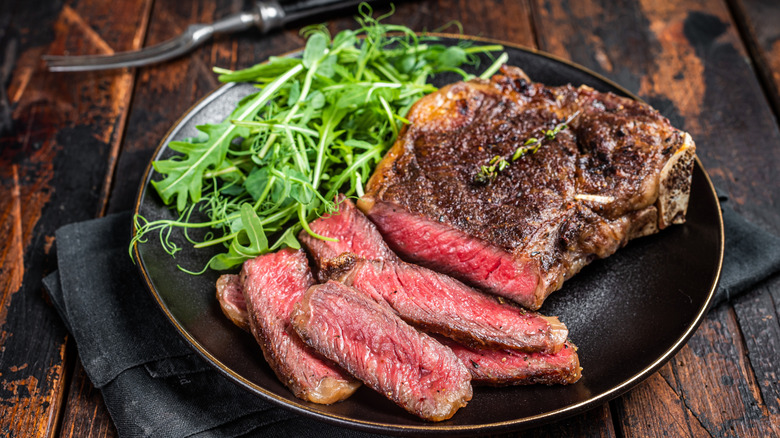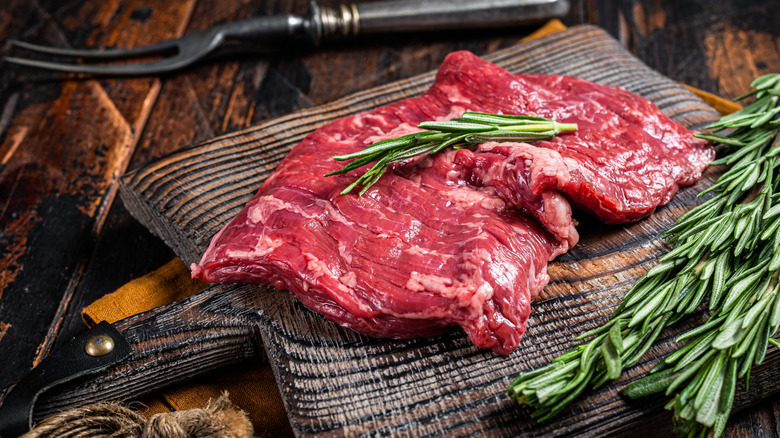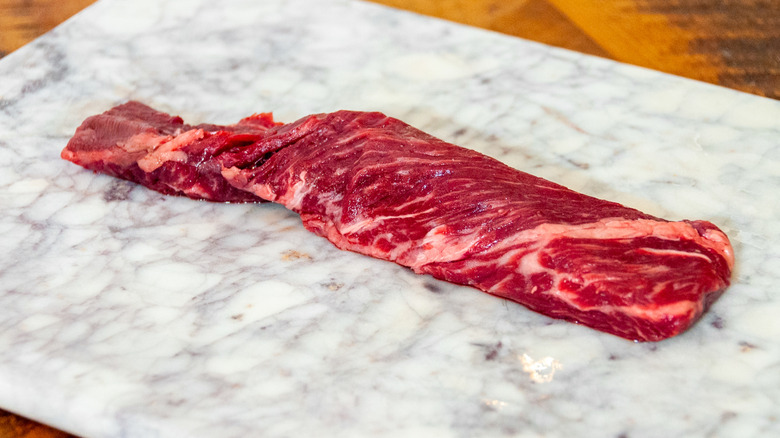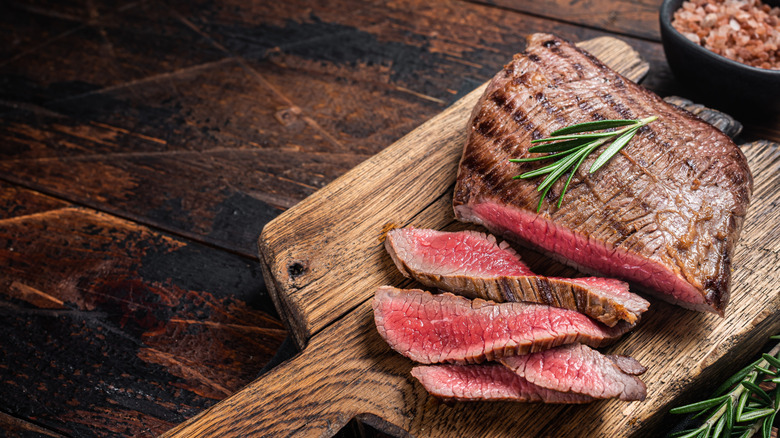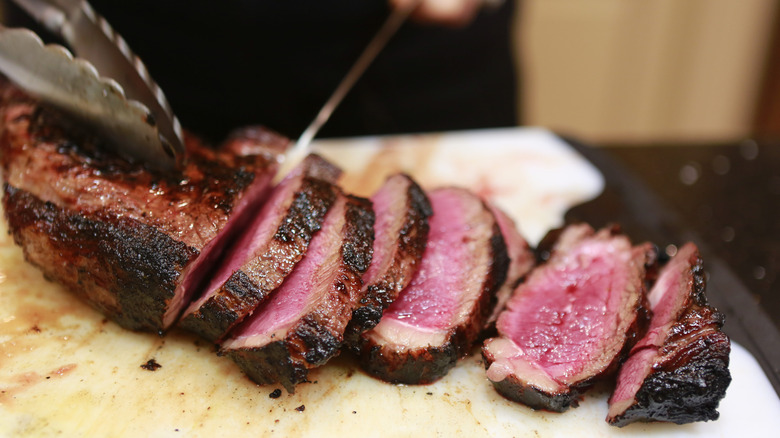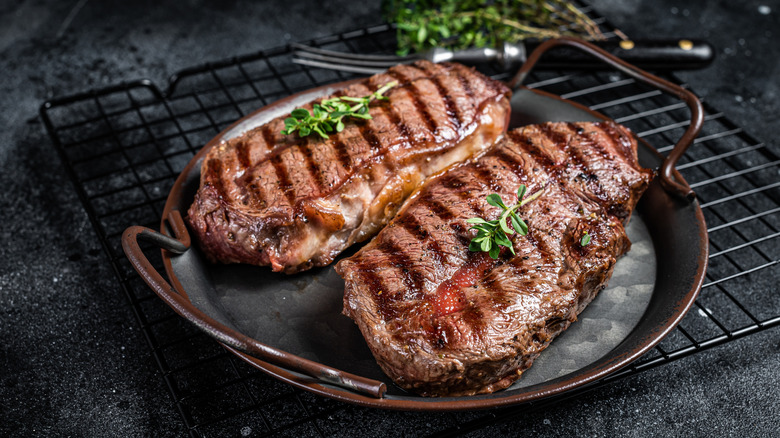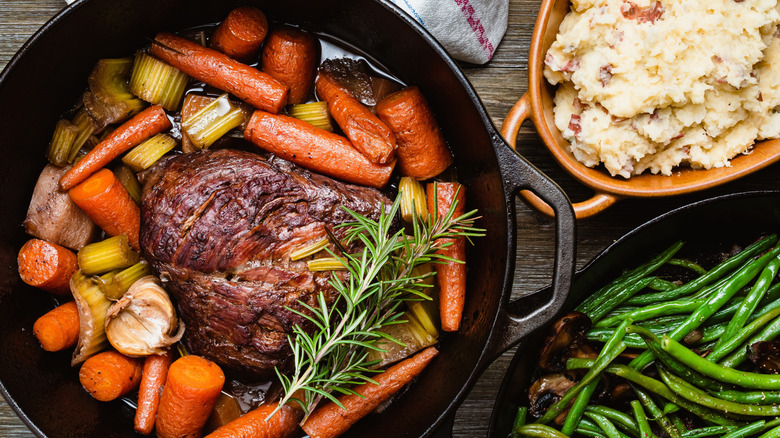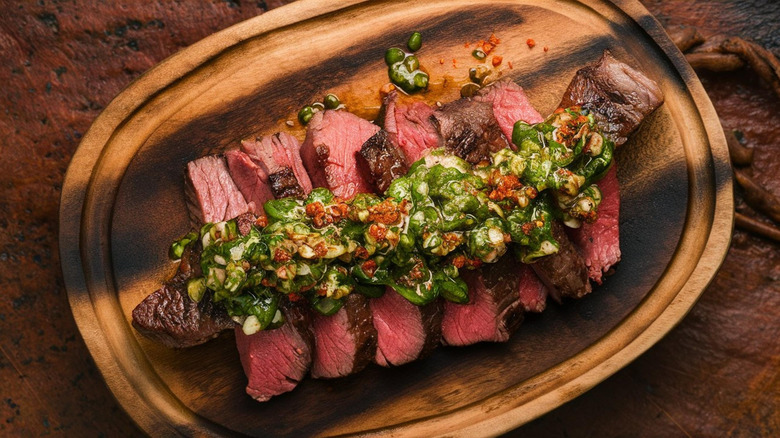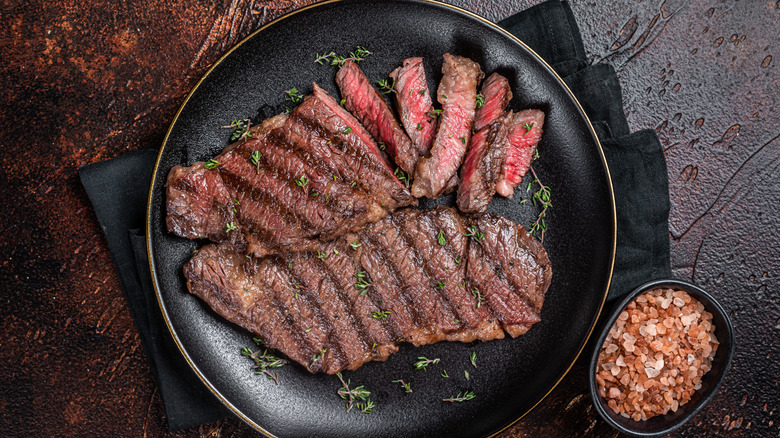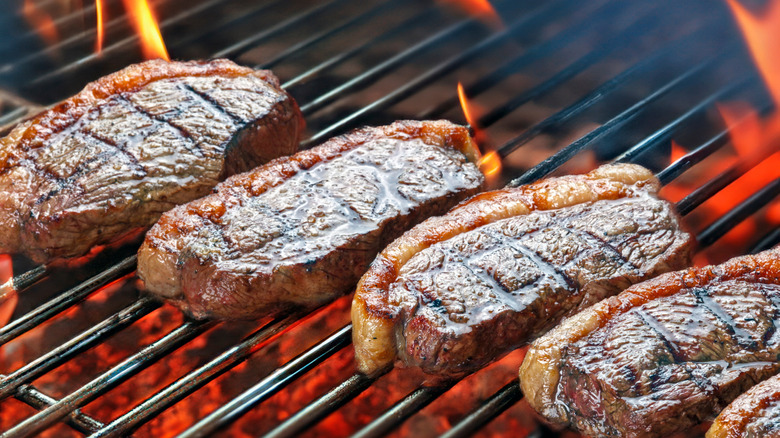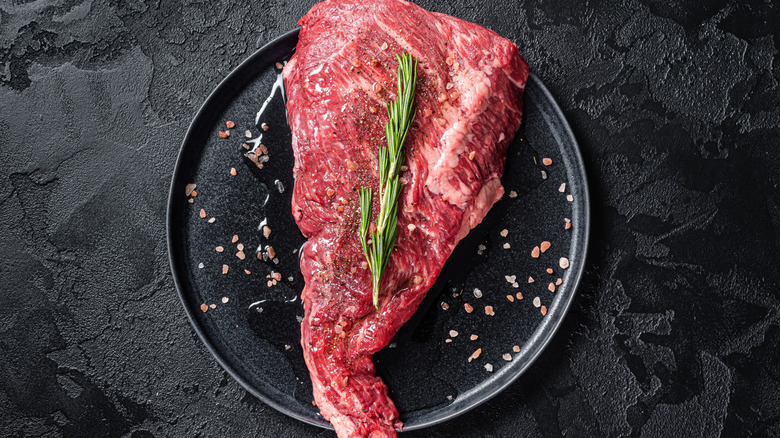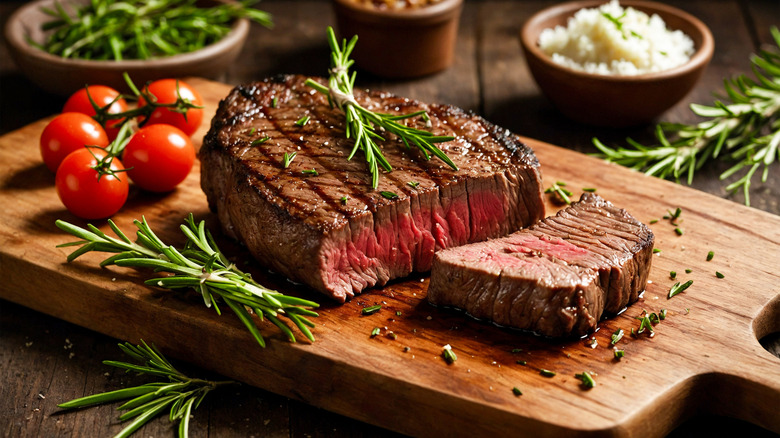11 Cheaper Cuts Of Steak That Experts Say Taste Expensive
Sometimes, it's fun to push the boat out and order the priciest steak on the menu, but always opting for premium cuts can be tough on your wallet. Heavy hitters, like Japanese Wagyu, filet mignon, and Kobe beef, usually cost upwards of $30 per pound or much more. Still, plenty of underused beef cuts taste just as good when prepared the right way. While you might not find all of these cuts on steakhouse menus, many chefs and butchers highly recommend them.
To find out about the most underrated meat and get some secrets on how to cook the juiciest steaks regardless of cut, we spoke with two culinary experts. Lisa Counts is the owner and executive chef at The Chopping Block, a Chicago-based cooking school that offers classes and private events. Meanwhile, Michael Handal is a chef at the Institute of Culinary Education in New York City. These industry professionals walked us through some of the best cheap cuts of steak that taste expensive and how to prepare these cuts to get the most out of them.
1. Skirt steak is great for a quick dinner
Skirt steaks are long cuts that come from the cow's diaphragm region. As these steaks come from fairly worked muscles, they are usually less tender than prime cuts and are not commonly found on steakhouse menus. Despite this, Chef Lisa Counts notes that "skirt steak is great grilled over high heat for a short amount of time [and] is best served medium rare to medium to maintain the meat's tenderness."
As skirt steak is thin and lean cut, so you need high heat to sear it quickly and prevent overcooking, which can increase the meat's potentially chewy texture. This is one of the main reasons steak tastes different at a restaurant compared with cooking at home, as professional kitchens are equipped with powerful stoves to rapidly bring meat to temperature, which helps it cook evenly.
If you're preparing skirt steak at home, use a marinade to soften the cut or tenderize it with a mallet before cooking. Chef Counts recommends using skirt steak to make quick weeknight dinners, such as fajitas, tacos, or steak and eggs. A 12-ounce skirt steak generally costs around $21-22 compared with $45 for the same amount of filet mignon.
2. Hanger steak is a secret among butchers
Hanger steak comes from the same part of the cow as skirt steak and is sometimes referred to as onglet steak or hanging tenderloin. Unlike skirt, which is thin and lean, hanger steak is a thicker, juicier cut with an intense, beefy flavor. Lisa Counts reveals that hanger steak is "also known as the butcher's steak because they would often keep it for themselves." High fat content is one of the reasons why Wagyu beef is so expensive, but unlike premium cuts, relatively cheap hanger steak can still be found at some butchers.
If you're preparing hanger at home, you need to remove the connective tissue that runs down the center of the steak, as this is chewy and won't tenderize during cooking. Although a softer cut than skirt, hanger steak can be prone to toughness if overcooked, so it is best kept below medium. Hanger steak is traditionally served with chimichurri sauce and can be braised or slow-cooked in a stew. According to Counts, "you can prepare it just like any other familiar cut of steak — grilled or pan sautéed to preferred temperature."
3. Flank steak is perfect for meal prepping
If you want more bang for your buck when it comes to meat, flank steak is an affordable option. Lisa Counts observes that she "loves flank steak because it can be prepared in a variety of ways [and] it's a larger cut, so you can really stretch the number of meals prepared with it." Flank steak comes from the cow's abdominal muscles and is a wide, flat cut with long muscle fibers running throughout. Besides the fact that it's a lean cut, these fibers can make flank steak prone to toughness. But there are many preparation hacks to get around this.
Counts explains that marination works well to tenderize flank steak and prevent it from becoming chewy. You can prepare a simple soy sauce, citrus juice, and brown sugar marinade and leave the meat to soak for up to two hours.
Unlike the one meat you should avoid cooking on the grill, marinated flank steak should be charred quickly and over high heat to retain a moist, juicy texture. You can also braise flank steak to make stew or braciole, a southern Italian dish of stuffed, slow-cooked beef. Once prepared, flank steak can be kept in the fridge for 3 to 4 days, meaning it's great for batch cooking and meal prep.
4. Use teres major for succulent beef medallions
Chef Michael Handal explains that "teres major is an often overlooked cut from the chuck or shoulder section of beef not always extracted [...] as it is more labor intensive to remove, but it is worth the effort." Comparable in flavor and tenderness with beef filet or tenderloin, Handal notes that one of the best ways to use teres major is to cut the steak into portions and make medallions. He recommends serving these with a red wine pan sauce. While he explains that teres major is naturally tender, avoiding overcooking it or having the heat too low when searing is still important.
Teres major is uniquely placed to be both flavorful and tender, as it comes from a fatty muscle that receives a lot of blood flow due to its position on the upper leg. As teres major is quite a small muscle, you are less likely to find it on restaurant menus as it is harder to source in large amounts. However, if you get your hands on some, you'll likely get more for your money, as teres major is priced lower than most premium steaks.
5. Flat iron steaks have juicy marbling
Like teres major, Michael Handal explains that flat iron steak comes from "an area of the cow [that] is not well exercised, so it is nice and tender and well marbled making it suitable for pan-searing, grilling, and stir-frying. It is considered an economical substitute for rib-eye and New York strips."
Flat iron steak comes from the cow's upper shoulder and is connected to the top blade by a sheet of tissue. Due to the dense amount of fat and marbling, this cut is juicy and has a tender bite that's comparable with many prime cuts when served medium or below. As noted by Handal, flat iron also scores in terms of affordability. You'll often find flat iron steak for around $10 less than the same amount of rib eye at both butcher's shops and restaurants.
However, flat iron is still considered a good cut as it comes from the unworked top of the beef, so you should be looking at mid-range prices on most restaurant menus. Prices that seem too low could be a sign of poor quality and are one of the red flags to watch out for when dining at a steakhouse.
6. Chuck roast is perfect for slow-cooking
Chuck roast or shoulder steak is a thick, muscular cut with tons of flavor. The chuck region of beef is around the well-worked neck and shoulder and contains several popular cuts, including flat iron, Sierra steak, and chuck eye. Lisa Counts notes that she loves chuck roast because "it tends to be cheaper than round, and you can get steaks from it, make pot roast, or roast it whole for a cheaper prime rib substitute."
Chuck roast also contains quite a lot of connective tissue, meaning it can be chewy if not prepared properly. Slow-cooking methods, like braising or roasting, give the tissue a chance to break down, enhancing the flavors in the beef and giving the meat a tender, flaky quality.
To get a really mouthwatering finish on your chuck roast, it's a good idea to brown the meat in a pan before putting it in the oven. Browning or searing your meat caramelizes the sugars and proteins on the surface to create a delicious outer layer. If you're putting your chuck into a stew to braise, you can slice it into large cubes for browning and then add it to your pot.
7. Western grillers are great bargain steaks
If you're looking for low-price steaks that have the same hearty flavor and juicy mouthfeel of a more expensive cut, Lisa Counts recommends the Western griller as a real bargain. A Western griller steak is "also known as bottom round steak and is a lean cut, so it's best to use a marinade to tenderize the meat before quickly grilling or pan-frying."
You can buy a whole bottom round roast and then cut it into western griller steaks yourself, taking care to trim away any tough fat from the outer layer. Remember to check which direction the grain runs in and slice the steaks to break the grain up. This is called cutting against the grain and usually involves chopping the meat horizontally if it is a long, rectangular piece. You should see which way the fibers run just by looking at the steak — slicing against the grain breaks down the chewy strips, giving you a much more enjoyable dining experience.
Even if you buy a whole roast instead of individual Western griller steaks, this is an extremely economical cut of meat. The bottom round is a worked muscle, so it is not prized for its tenderness like fattier cuts. You can buy a bottom round roast for around $4-5 per pound and get several steaks out of it, rather than paying almost $40 by the pound for choice steaks like a filet mignon.
8. Start Denver steaks low and slow
When it comes to underrated steaks, Lisa Counts notes that Denver steak has been steadily increasing in visibility and is now sold across many stores. One reason for this rise, she explains, is that Denver steak "has a deeply meaty flavor yet is still a lean cut." Another shoulder cut, Denver steaks, comes from the chuck roll, which is located below the shoulder blade.
Unlike other inexpensive cuts that should be cooked on high heat to help them stay tender, Counts recommends a "reverse sear technique" for preparing Denver steaks. This means you slow-cook the steak over low heat or in a low-temperature oven and then give it a quick sear on a high flame. Counts explains that this helps give the steak an even sear throughout, while still letting the juiciness of this well-marbled cut shine through. You can also cook Denver steak in a sous vide water bath to seal in flavor, then finish it in a hot pan for a lovely brown finish.
9. Try picanha cuts at a Brazilian steakhouse
If you want a high-end but low-cost experience at a Brazilian steakhouse, Michael Handal suggests ordering picanha steak. Handal explains that "picanha steaks are a cut of beef popularized in Brazil and Portugal as an important part of their churrasco grills [and] are sometimes considered a budget-friendly substitute for the more expensive ribeye steak." Brazilian steakhouses differ from those in the U.S. due to churrasco grills, where meat is grilled on long skewers and then carved at the table.
Picanha steaks come from the bottom round rump region of the cow and are extremely tender. Handal notes that they also have a moderate fat content, making them juicy when served medium-rare or below. While you'll most likely find picanha on the menu at Brazilian steakhouses, you can buy picanha roasts from some butchers and cut them into steaks yourself. Picanha rump roasts should weigh around 3 pounds and have a robust fat cap on top that should be at least half an inch thick.
10. Tri-tip steaks are highly versatile
Discussing tri-tip steaks, Michael Handal states that the "tri-tip comes from the very lower section of the beef primal [and] may replace a more expensive rib-eye or filet mignon." Handal describes tri-tip as a lower-fat equivalent to picanha, which also comes from the rump or sirloin region. Tri-tip steaks are lower in calories compared with picanha and are extremely versatile.
Handal notes that you can prepare tri-tips steaks using dry heat on the grill or throw them in a stew or braise for a long, slow simmer. Wet cooking keeps the meat moist and brings a rich flavor to broths and gravies. Grilled tri-tip has a strong flavor similar to brisket and can become even more tender and delicious when marinated. This cut is particularly popular on the West Coast — sometimes referred to as a Santa Maria steak – and is often prepared using a salt and spice rub or a herb and vinegar marinade.
11. Merlot steak has a velvety texture
Michael Handal explains that merlot steak — which comes from the hind leg or heel area of beef — is sometimes referred to as "velvet" steak because of its smooth, lean bite. He adds that, "merlot steak is similar to a flank steak but with a finer texture. It is very lean and flavorful but may also be marinated before cooking [...] and served with chimichurri." Merlot steak can also be pan-seared and served with a pan sauce reduction.
Given how lean this cut is, it should be served medium-rare as overcooking will dry the meat out and make it chewy. You must also make sure to slice it against the grain to cut through tough muscle fibers.
Merlot steak is not commonly found on steakhouse menus, but a knowledgeable butcher can help you track down this rare cut. Despite its mouthwatering texture, merlot steak is still highly affordable, at roughly $10-12 for an 8-12 ounce piece.
